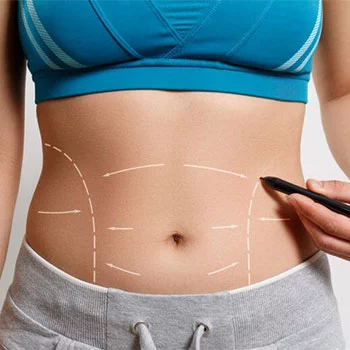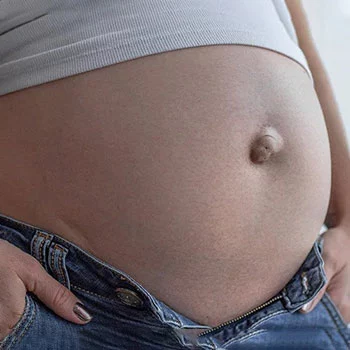What is belly button surgery?
Belly button surgery, also known as umbilicoplasty, is a cosmetic procedure that aims to alter the appearance of the belly button (navel). This type of surgery is typically done to improve the aesthetic appearance of the belly button by reshaping it, reducing its size, correcting any protrusion or asymmetry, or removing excess skin around the area. Umbilicoplasty is considered a relatively minor cosmetic surgery procedure and is often performed on an outpatient basis under local anesthesia.
Why is belly button surgery needed?
Belly button surgery, or umbilicoplasty, may be desired for various reasons, including:
- Cosmetic enhancement: Some individuals may wish to improve the appearance of their belly button due to dissatisfaction with its size, shape, protrusion, or asymmetry. Umbilicoplasty can help achieve a more aesthetically pleasing belly button.
- Post-pregnancy changes: Pregnancy can cause changes to the belly button, such as stretching of the skin or separation of the muscles, which may lead some women to consider umbilicoplasty to restore the pre-pregnancy appearance.
- Weight loss: Significant weight loss can result in excess skin around the belly button area, leading to sagging or an unsightly appearance. Belly button surgery can help address these concerns.
- Correction of birth defects: In some cases, individuals may have congenital abnormalities or deformities of the belly button that can be corrected through umbilicoplasty. These deformities are:
- Revision surgery: People who have undergone previous abdominal surgeries or procedures, such as tummy tucks, may opt for belly button surgery to revise or improve the appearance of their belly button.
Ultimately, the decision to undergo belly button surgery is a personal choice, and individuals should consult with a qualified plastic surgeon to discuss their goals, expectations, and candidacy for the procedure.
Belly button shapes
The belly button or navel, technically known as the umbilicus, can come in various shapes and sizes, influenced by factors such as genetics, body composition, and individual anatomy. Some common belly button shapes include:
- Innie: An "innie" belly button is the most common shape, where the navel is concave or indented into the abdomen. This shape is typically smooth and inward-facing.
- Outie: An "outie" belly button protrudes outward from the abdominal wall, often due to a small umbilical hernia or excess scar tissue from the umbilical cord.
- Vertical: A vertical belly button has a more elongated shape, with the top and bottom portions of the navel appearing slightly elongated vertically.
- Horizontal: A horizontal belly button is wider than it is tall, with a more horizontally oriented shape compared to the vertical belly button.
- T-shaped: A T-shaped belly button has a small vertical indentation with horizontal ridges or folds extending outwards, resembling the shape of the letter "T."
- Oval: An oval-shaped belly button is elongated either vertically or horizontally, creating an oval outline rather than a perfectly round shape.
- Round: A round belly button is symmetrical and circular in shape, with no prominent indentations or protrusions.
- S-shaped: An S-shaped belly button may have a curving or twisting shape, resembling the letter "S" in its contour.
- Hooded belly button: A hooded belly button is characterized by excess skin covering the belly button, creating a hood-like appearance. Surgery can remove the excess skin and reshape the belly button for a smoother contour.
It is important to note that belly button shapes can vary widely among individuals, and there is no standard classification system for categorizing all possible variations. Additionally, changes in the shape of the belly button can occur due to factors such as weight fluctuations, pregnancy, aging, or surgical procedures.
Anyway, every individual with any belly button shape may wish to have the shape altered. For instance, one may have an innie belly button that they wish to convert to an outie or vice versa. Umbilicoplasty can help reshape the belly button to achieve the desired appearance.
Who is a suitable candidate for umbilicoplasty?
Suitable candidates for umbilicoplasty typically include individuals who:
- Have cosmetic concerns: Candidates who are bothered by the appearance of their belly button due to factors such as size, shape, protrusion, asymmetry, or scarring may be suitable candidates for umbilicoplasty.
- Are in good health: Candidates should be in good overall health and free from medical conditions that could increase the risks of surgery or interfere with the healing process.
- Have realistic expectations: Candidates should have realistic expectations about the outcomes of umbilicoplasty and understand that the surgery can improve the appearance of the belly button but may not achieve perfection.
- Non-smokers: Non-smokers are preferred candidates for umbilicoplasty, as smoking can impair the healing process and increase the risk of complications.
- Maintain stable weight: Candidates should be at a stable weight and maintain a healthy lifestyle. Significant weight fluctuations after the surgery can impact the results of umbilicoplasty.
- Are willing to follow post-operative care: Candidates should be willing to follow the surgeon's post-operative care instructions, including proper wound care, activity restrictions, and attending follow-up appointments.
- Have specific concerns about their belly button: Candidates should have specific aesthetic concerns about their belly button that they wish to address through surgery, such as correcting asymmetry, reducing protrusion, or improving the overall appearance.
It is important to consult with a board-certified plastic surgeon to determine if you are a suitable candidate for umbilicoplasty. During the consultation, the surgeon will evaluate your individual needs, discuss your goals, and recommend the most appropriate treatment plan to achieve the desired aesthetic results.
How is belly button surgery performed?
Belly button surgery, or umbilicoplasty, is typically performed as an outpatient procedure and involves the following steps:
- Anesthesia: The surgery is usually performed under local anesthesia with sedation to ensure the patient's comfort throughout the procedure.
- Incision: The surgeon will make incisions around the belly button, depending on the specific goals of the surgery. The incisions may be made within the belly button itself or around its perimeter.
- Reshaping: The surgeon will reshape the belly button by removing excess skin, adjusting the size, correcting asymmetry, or addressing any protrusion to achieve the desired aesthetic outcome.
- Closure: Once the reshaping is complete, the incisions are carefully closed with sutures to secure the new belly button shape and minimize scarring.
- Bandaging: The treated area is then covered with bandages or dressings to protect the incisions and promote proper healing.
- Recovery: After the surgery, patients are usually monitored for a short period in the recovery room before being discharged. The surgeon will provide instructions on post-operative care, including wound care, activity restrictions, and follow-up appointments.
It is crucial to choose a board-certified plastic surgeon with experience in performing umbilicoplasty to ensure a safe procedure and achieve the desired aesthetic outcomes. The surgeon will discuss the specific details of the surgery, including the techniques used and the expected recovery process, during the pre-operative consultation.
How to prepare for the procedure
To prepare for belly button surgery consider the following steps to ensure a smooth and successful procedure:
- Consultation: Schedule a consultation with a board-certified plastic surgeon to discuss your goals, concerns, medical history, and expectations for the surgery. The surgeon will evaluate your candidacy for umbilicoplasty and provide personalized recommendations.
- Medical evaluation: Undergo a thorough medical evaluation to assess your overall health and identify any potential risk factors that may affect the surgery or recovery process.
- Quit smoking: If you smoke, it is advisable to quit smoking several weeks before the surgery. Smoking can impair healing and increase the risk of complications.
- Medication review: Inform your surgeon about any medications, supplements, or herbal remedies you are taking. Your surgeon may advise you to adjust or stop certain medications before the surgery.
- Follow pre-operative instructions: Follow any pre-operative instructions provided by your surgeon, such as fasting before the surgery, avoiding certain medications, and staying hydrated.
- Arrange transportation: Arrange for someone to drive you to and from the surgical facility on the day of the procedure, as you may not be able to drive yourself home after undergoing anesthesia.
- Prepare your recovery space: Set up a comfortable recovery space at home with necessary supplies, such as loose and comfortable clothing, pillows for support, and any prescribed medications.
- Plan for assistance: Arrange for someone to assist you during the initial days of recovery, as you may need help with daily activities and tasks.
- Follow a healthy diet: Maintain a healthy diet leading up to the surgery to support your body's healing process and recovery.
- Stay hydrated: Drink plenty of water in the days leading up to the surgery to stay hydrated and promote optimal recovery.
By following these preparation steps and adhering to your surgeon's guidance, you can help ensure a successful and safe umbilicoplasty procedure and enhance your overall surgical experience.
What to expect after the procedure
After undergoing umbilicoplasty, it is important to know what to expect during the recovery process. Here are some common post-operative experiences and guidelines:
- Swelling and bruising: Expect some degree of swelling and bruising around the treated area. This is a normal part of the healing process and should gradually improve over time.
- Discomfort: You may experience some discomfort or mild pain following the surgery. Your surgeon may prescribe pain medication to help manage any discomfort during the initial stages of recovery.
- Dressing care: Follow your surgeon's instructions on how to care for the dressings covering the incision site. It is important to keep the area clean and dry to prevent infection.
- Activity restrictions: Your surgeon will provide specific guidelines on activity restrictions, including avoiding strenuous activities, heavy lifting, and bending, to allow for optimal healing.
- Follow-up appointments: Attend all scheduled follow-up appointments with your surgeon to monitor your healing progress and address any concerns or questions you may have.
- Scar care: Your surgeon may recommend scar care techniques to help minimize the appearance of scars over time. Follow their instructions on scar management for the best results.
- Gradual return to normal activities: As you recover, gradually ease back into your normal daily activities, following your surgeon's recommendations to avoid complications.
- Results: It may take several weeks to months for the final results of the umbilicoplasty to become fully apparent as swelling subsides and the tissues heal. Be patient with the healing process and give your body time to recover.
- Diet and hydration: Maintain a healthy diet and stay hydrated to support your body's healing process and promote optimal recovery.
- Contact your surgeon: If you experience any unusual symptoms or complications, or have concerns during your recovery, contact your surgeon promptly for guidance and assistance.
By following your surgeon's post-operative instructions, taking care of yourself, and allowing ample time for healing, you can optimize your recovery experience and achieve the desired aesthetic outcomes of your belly button surgery.
Risks and complications
Umbilicoplasty, like any surgical procedure, carries inherent risks and potential complications that patients should be aware of before undergoing the surgery. Some of the risks associated with belly button surgery include:
- Infection: There is a risk of developing an infection at the surgical site, which may require antibiotics or further treatment.
- Bleeding: Excessive bleeding during or after the surgery is a potential complication that may necessitate medical intervention.
- Swelling and bruising: Some degree of swelling and bruising is common after umbilicoplasty and usually resolves over time.
- Scarring: While efforts are made to minimize scarring, some degree of scarring is unavoidable with any surgical procedure.
- Pain and discomfort: Patients may experience pain and discomfort at the surgical site, which can usually be managed with prescribed pain medication.
- Asymmetry: Despite efforts to achieve symmetry, there is a risk of post-operative asymmetry in the appearance of the belly button.
- Delayed healing: Factors such as poor wound care, underlying health conditions, or smoking can contribute to delayed wound healing.
Rare complications
- Nerve damage: In rare cases, nerve damage may occur, leading to altered sensation in the abdominal area.
- Hematoma: A collection of blood under the skin (hematoma) may occur and require drainage.
- Seroma: Fluid accumulation under the skin (seroma) is a possible complication that may need to be drained.
- Wound dehiscence: The incision site may reopen partially or completely, requiring additional treatment.
- Allergic reaction: Rarely, patients may experience an allergic reaction to anesthesia, medications, or surgical materials used during the procedure.
It is important for patients to discuss these risks and potential complications with their plastic surgeon before undergoing umbilicoplasty. By understanding the possible outcomes and following pre-operative and post-operative instructions diligently, patients can help minimize risks and optimize their surgical results. Promptly notifying the surgeon of any unusual symptoms or concerns during the recovery period is crucial for early intervention if complications arise.
Cost
The cost of belly button surgery can vary depending on various factors such as the surgeon's experience, the geographic location of the practice, the complexity of the procedure, the facility fees, anesthesia fees, and any post-operative care required. On average, the cost of umbilicoplasty in the United States can range from $2,000 to $5,000 or more.
It is essential to note that the cost of umbilicoplasty is typically not covered by health insurance as it is considered a cosmetic procedure. Patients considering umbilicoplasty should schedule a consultation with a board-certified plastic surgeon to discuss their specific goals, assess candidacy for the procedure, and obtain an accurate cost estimate based on their individual needs.
During the consultation, the surgeon will evaluate the patient's abdominal area, discuss the desired outcomes, explain the surgical technique, and provide details regarding the associated costs. Patients should inquire about any additional fees, payment options, financing plans, and what is included in the total cost to ensure they have a comprehensive understanding of the financial aspects of the procedure.
Umbilicoplasty after pregnancy
Umbilicoplasty, or belly button surgery, can be considered after pregnancy to address changes in the appearance of the belly button that may occur due to pregnancy-related factors such as stretching of the skin, protrusion, or asymmetry.
It is advisable to wait until you have completed your family planning and do not plan on having any more children before undergoing umbilicoplasty. This is because future pregnancies can affect the results of the surgery. It is also recommended to achieve a stable weight before considering belly button surgery after pregnancy. Significant weight fluctuations can impact the results of the surgery.
In some cases, umbilicoplasty may be combined with other procedures such as abdominoplasty (tummy tuck) or mommy makeover to address additional concerns related to pregnancy-related changes in the abdominal area.
Umbilicoplasty vs. hernia repair surgery
Umbilicoplasty and hernia repair surgery are two distinct procedures that involve the abdominal area but serve different purposes. Here are the key differences between the two procedures:
Purpose
Umbilicoplasty is a cosmetic procedure aimed at improving the aesthetics of the belly button. It is commonly performed to address concerns such as shape, size, symmetry, protrusion, or scarring of the belly button.
Hernia repair surgery is a medical procedure performed to repair a hernia, which occurs when an internal organ or tissue protrudes through a weak spot in the abdominal wall.
Candidates
Suitable candidates for umbilicoplasty are individuals who have cosmetic concerns about their belly button and wish to enhance its appearance.
Candidates for hernia repair surgery are individuals diagnosed with a hernia, which can present as a bulge or lump in the abdomen, groin, or other areas.
Procedure
Umbilicoplasty involves reshaping the belly button through surgical techniques such as removing excess skin, adjusting the size, correcting asymmetry, or improving the overall appearance.
Hernia repair surgery involves reinforcing the weakened abdominal wall with sutures, mesh, or other techniques to prevent the hernia from protruding further.
FAQs
Does belly button surgery hurt?
During an umbilicoplasty surgery, patients are typically under the effects of anesthesia, which means they do not feel pain during the procedure. After the surgery, patients may experience soreness, swelling, and tenderness at the surgical site, which can typically be managed with prescribed pain medication and following post-operative care instructions.
Will I get scars after belly button surgery?
Scarring is a common outcome of any surgical procedure, including belly button surgery. While efforts are made to minimize scarring during umbilicoplasty, some degree of scarring is inevitable. The appearance of scars can vary depending on individual healing factors and the surgical technique used.
How long does belly button surgery take?
On average, umbilicoplasty can take approximately 1 to 2 hours to complete under general anesthesia.




